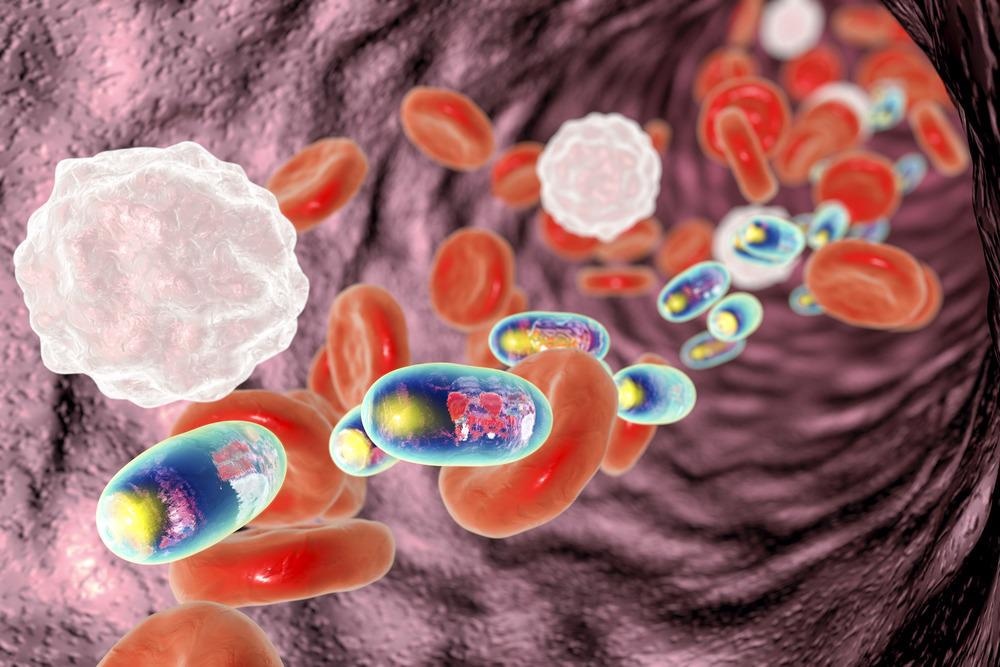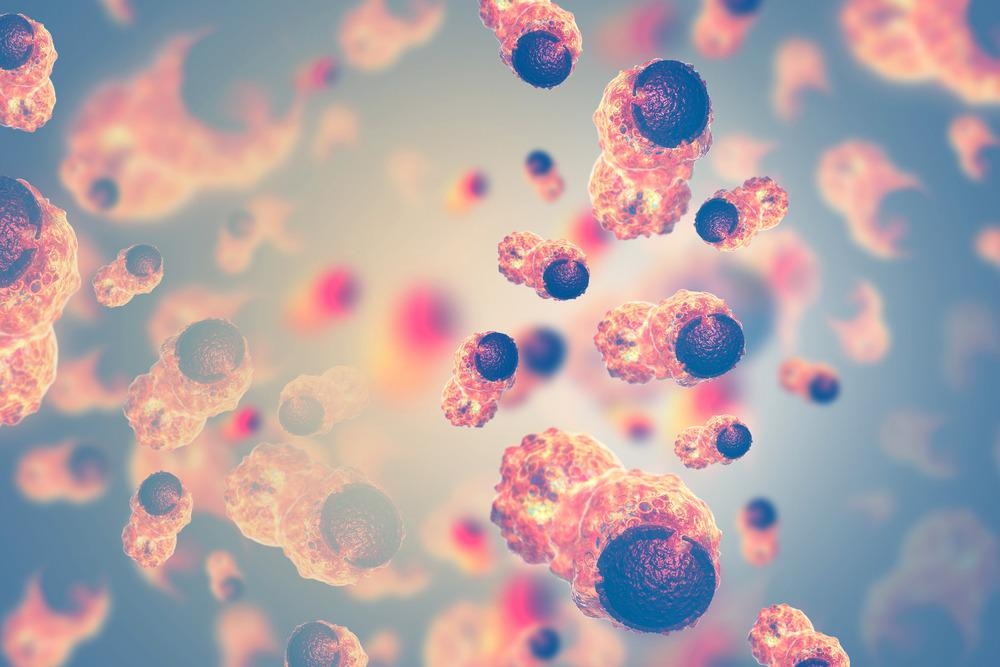Cancer research has become a focal point for advanced and innovative therapeutics, and with novel nanoparticle developments, research into new treatments is gaining traction. Chitosan nanoparticles have an esteemed reputation within various fields such as nanomedicine, biomedical engineering, and drug delivery.

Image Credit: Kateryna Kon/Shutterstock.com
Chitosan can be classified as a linear polysaccharide obtained from chitin, consisting of β-(1,4)-linked N-acetyl glucosamine units. This derivative of chitin can be produced through common sources such as fungi and the exoskeleton of crustaceans and insects.
Transforming chitosan from chitin can be accomplished through the process of deacetylation. This can include using chemicals such as a strong solution of sodium hydroxide (25–50%) and a high temperature (90–120 ºC), or through a biochemical route involving the enzyme deacetylase.
Benefits of Chitosan Within Nanoparticle Manufacturing
Chitosan is a beneficial component that further enhances nanoparticles' applications.
The manipulation of various deacetylation reaction conditions resulting in chitosan polymers from their chitin source can enable a range of different polymer sizes – a useful component for controlling nanoparticle size.
This also results in various molecular weights from 300 to over 1000 kD as well as impacting the physicochemical properties such as viscosity and solubility.
Chitosan is insoluble in water at a neutral pH, but due to the protonation of its free amine groups, it can dissolve in dilute acids. Consequently, cationic chitosan retains solubility in dilute acids such as acetic, formic, and citric, which directly correlates to its degree of deacetylation.
The amine groups of chitosan also affect its use in pharmaceutical and biomedical applications, with heightening characteristics such as mucoadhesion, permeation enhancement, transfection, and in situ gelation.
Chitosan Applications
Chitosan-based nanoparticles can be utilized for drug delivery of active ingredients or natural substances, with their versatile nature enabling various administration routes, including oral and parenteral delivery.
Nanoparticles incorporating chitosan are also effective for local delivery at the dermis and the mucosa level, including the nasal, buccal, pulmonary, and rectal routes. These applications benefit from chitosan's mucoadhesive and permeability-enhancing characteristics.
Natural properties, size tuneability, and surface modification enable this critical polymer to be a promising component when strategizing how to overcome bioavailability and stability issues during drug delivery.
The versatile nature of chitosan enhances its desirability for various applications from nanomedicine, biomedical engineering, and therapies that can be tailored for various diseases and disorders, including cancer treatment.
With an increased level of bioavailability, enhanced specificity and sensitivity, and reduced pharmacological toxicity, chitosan-based nanoparticles can make for a very effective and innovative drug delivery system. The development of this system can enable sustained drug release and modifications to target specific tissues, sparing healthy tissue, and enhance personalized medicine to improve the quality of care in patients.
Chitosan nanoparticles and dry powder inhalation
Video Credit: TheQUTube/YouTube.com
Chitosan nanoparticles with a size range of 10 to 80 nm have already been shown to have potential in these fields. Its ability to alter protein loading and ease in storage and transport further increase its use in nanomedicine.
Additionally, clinical applications, including chitosan nanoparticles for diagnosis and cancer therapeutics, have been explored due to their minimal systemic toxicity within in vitro and some in vivo models. Chitosan-based nanoparticles were also found to have maximal cytotoxicity against cancer cells and tumors.
This critical research involving chitosan-based nanoparticles has led to drug delivery systems for pre-clinical and clinical studies. However, the translation of novel nano-drug delivery systems into clinical applications may require a collective approach from collaborative researchers and industrial leaders.
Challenges
A limitation of chitosan for pharmaceutical applications includes a careful choice of the correct type of material. With the wide range of chitosan polymers available, the requirement for the correct molecular weight, degree of acetylation, and purity grade can be a difficult choice.
Some guidelines can be found in pharmacopeias regarding the purity and degree of acetylation, with the most frequent impurities within chitosan including ash, heavy metals, and proteins.
Proteins can impact biological activity due to their ability to affect immunogenicity and high ash and residual protein volume can impact dissolution, which may cause difficulty when preparing chitosan-based drug delivery systems.
These challenges can be overcome with further research focused on the optimal condition for deacetylation reactions, resulting in an optimized and effective chitosan-based nanoparticle targeted for specific applications.

Image Credit: crystal light/Shutterstock.com
Future Outlook
With already established research on gold nanoparticles spearheading nanoparticle research, incorporating chitosan into nanotechnology in this manner would not be a difficult feat for researchers. Gold nanoparticles have been researched and tested for facilitating prolonged drug release as a drug delivery system. The addition of chitosan for its remarkable physicochemical and biological characteristics would only further enhance research into innovative therapeutics.
Used as a nanocarrier for anti-cancer drugs, chitosan-based nanoparticles can revolutionize cancer treatment, reduce the impact of toxicity from the drugs on healthy tissue, and increase the specificity and sensitivity towards cancerous areas. This is a crucial benefit that will improve the quality of treatment provided to cancer patients, who often suffer from toxicities in healthy tissue, which can cause unnecessary organ damage and failure.
The use of chitosan within nanoparticles to improve clinical treatments can aid in developing and advancing personalized medicine, serving to hold patient quality and care as a priority. Translating this as a clinical application may be challenging, but with a collaborative effort from industrial leaders, chitosan-based nanoparticles hold a strong potential for advancing therapeutics.
Continue reading: Sustainable Recovery of Rare Earth Elements with Cellulose Nanocrystals.
References and Further Reading
Nurunnabi, M., Revuri, V., Huh, K. and Lee, Y., (2017) Polysaccharide based nano/microformulation: an effective and versatile oral drug delivery system. Nanostructures for Oral Medicine, pp.409-433. Available at: https://doi.org/10.1016/B978-0-323-47720-8.00015-8
Sharifi-Rad, J., et al (2021) Chitosan nanoparticles as a promising tool in nanomedicine with particular emphasis on oncological treatment. Cancer Cell International, 21(1). Available at:
https://doi.org/10.1186/s12935-021-02025-4
Disclaimer: The views expressed here are those of the author expressed in their private capacity and do not necessarily represent the views of AZoM.com Limited T/A AZoNetwork the owner and operator of this website. This disclaimer forms part of the Terms and conditions of use of this website.